 |
|
 |
July 2012 |
 |
|

|
 |
Feature Article
|
 |
 |
Global Market for Battery Control Technology: Battery Chargers, Smart Batteries and Battery Conditioners
Donald Saxman, BCC Research
Rechargeable batteries are routinely used in portable product and stationary power applications including computers, cellular phones, and uninterruptible and emergency power supplies. More recently, rechargeable vehicle batteries have evolved from relatively low performance industrial vehicles to electric vehicles that rival internal combustion vehicles in performance and exceed their efficiency.
...read more
|
|
 |

|
| |
Sponsored Announcement |
 |
Albér Stationary Battery Seminars Help Ensure Performance of Your DC System and Assist with NERC Compliance
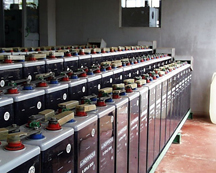 If you or others in your company are responsible for the installation, testing, maintenance, NERC compliance, specification and/or design of stationary battery systems, this seminar is for you! If you or others in your company are responsible for the installation, testing, maintenance, NERC compliance, specification and/or design of stationary battery systems, this seminar is for you!
Alber has been presenting battery seminars to educate people, providing fundamental knowledge about these systems. We have an excellent record in providing accurate, timely information, keeping up with industry standards and practices. Our training staff possesses extensive experience in the installation, operation, maintenance and testing of batteries employed in UPS, electric utility, telecom and other applications. Let Alber help you with NERC compliance!
Alber seminars focus on safeguarding backup systems through proper battery maintenance and testing. A seminar covers industry standards, equipment and methodologies. Attendees who complete the Stationary Battery Basics seminar earn 1.6 Continuing Education Units and are awarded a certificate to provide documentation of attendance. Alber also offers on-site seminars adjusted to company needs.
Seminars explore topics such as electrochemistry fundamentals, installation, testing, inspection, maintenance, charging, safety, monitoring, and load testing. We also offer training for specific Alber products alone or combined with the Battery Basics Seminar.
Public seminars are offered in Columbus Ohio. Alternatively, this seminar can be presented at your facility with focus on your specific systems.
For more information regarding Alber training and seminars, contact Rick Tressler at 954-623-6660, extension 23856 or via Rick.tressler@alber.com. Detailed course descriptions can be viewed at www.alber.com.
Microchip Launches 8-bit Microcontrollers with Integrated Configurable Logic in 6- to 20-pin Packages
The PIC10F(LF)32X and PIC1XF(LF)150X MCUs each feature new peripherals, including Configurable Logic Cells (CLCs), Complementary Waveform Generators (CWGs) and Numerically Controlled Oscillators (NCOs), enabling functionality that was not possible before with low pincount MCUs. These general-purpose MCUs enable designers to enhance the functionality, reduce design size, and decrease the cost and power consumption of products.
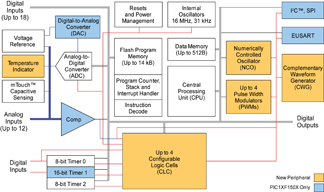 The CLC peripherals on the PIC10F(LF)32X and PIC1XF(LF)150X MCUs enable software control of combinational and sequential logic, which increases the on-chip interconnection of peripherals and I/Os, thereby reducing external components, saving code space and adding functionality. The CWG peripheral works with multiple peripherals to generate complementary waveforms with dead-band control and auto shutdown, which provides improved switching efficiencies. Additionally, the NCO peripheral enables linear frequency control and high resolution, which is required for applications such as lighting ballast, tone generation and other resonant control circuits. The MCUs also feature low power consumption, with currents of less than 30 µA/MHz in active mode, and less than 20 nA in sleep; as well as an on-chip 16 MHz internal oscillator, Analog-to-Digital Converter (ADC), and up to 4 Pulse-Width Modulation peripherals. An integrated temperature-indicator module enables low-cost temperature measurements. The CLC peripherals on the PIC10F(LF)32X and PIC1XF(LF)150X MCUs enable software control of combinational and sequential logic, which increases the on-chip interconnection of peripherals and I/Os, thereby reducing external components, saving code space and adding functionality. The CWG peripheral works with multiple peripherals to generate complementary waveforms with dead-band control and auto shutdown, which provides improved switching efficiencies. Additionally, the NCO peripheral enables linear frequency control and high resolution, which is required for applications such as lighting ballast, tone generation and other resonant control circuits. The MCUs also feature low power consumption, with currents of less than 30 µA/MHz in active mode, and less than 20 nA in sleep; as well as an on-chip 16 MHz internal oscillator, Analog-to-Digital Converter (ADC), and up to 4 Pulse-Width Modulation peripherals. An integrated temperature-indicator module enables low-cost temperature measurements.
To facilitate application development, the PICDEM Lab Development Kit (part # DM163045, $134.99) now includes samples of both the PIC10F322 and PIC16F1507 MCUs. Additionally, the F1 Evaluation Platform (part # DM164130-1, $39.99) is available for development with enhanced mid-range core 8-bit PIC MCUs, including the PIC1XF(LF)150X family. Also available is a free CLC Configuration Tool, to streamline the setup process of the CLC module by simulating the functionality of the registers and combinational logic in a graphical user interface (GUI).
The PIC10F(LF)320 and PIC10F(LF)322 MCUs are available in a 6-pin SOT-23 package, as well as 8-pin PDIP and 2 mm x 3 mm DFN packages. The PIC12F(LF)1501 MCU will be available in 8-pin PDIP, SOIC, MSOP and 2 mm x 3 mm DFN packages, and the PIC16F(LF)1503 MCU in 14-pin PDIP, SOIC and TSSOP packages, as well as a 3 mm x 3 mm QFN package. The PIC16F(LF)1507 MCU is available in 20-pin SSOP, PDIP, SOIC, and 4 mm x 4 mm QFN packages, as will the PIC16F(LF)1508/9 MCUs, when available. Pricing starts at $0.37 each, in 10,000-unit quantities.
Click here for more information.
|
 |
 |
| |
New Products |
| |
Infinite Power Solutions Launches Self-Powered Wireless Environmental Sensor Eval Kit
Infinite Power Solutions, Inc. (IPS) has released the IPS-EVAL-EH-02 Wireless Environmental Sensor Energy Harvesting Evaluation Kit. The evaluation kit is a complete wireless sensor reference design that includes a microcontroller and radio module from Microchip Technology and multiple indoor environmental sensors.
System power is provided by a paper-thin THINERGY Micro-Energy Cell (MEC), an eco-friendly, all-solid-state battery solution that is continuously recharged using ambient energy harvesting, allowing decades of autonomous, maintenance-free operation. THINERGY MECs enable low cost, hassle-free, permanent power solutions for a variety of low power, small form factor, industrial and consumer wireless sensor applications. This evaluation kit will help designers develop self-powered wireless sensors for smart home and building automation systems.
The IPS-EVAL-EH-02 evaluation kit enables design engineers to develop and evaluate self-sustaining "green" sensor solutions, displacing the use of conventional batteries and supercapacitors that require frequent replacement, especially when exposed to elevated temperature conditions. The kit includes a variety of integrated environmental sensors, such as a Passive Infra-Red (PIR) occupancy sensor, a humidity sensor, an ambient light sensor and a temperature sensor. The sensor system and data transfer is managed by the Microchip PIC24 microcontroller. A MiWi IEEE 802.15.4 compliant radio module, also from Microchip, is used to communicate with the Zena 2.4 GHz Wireless Adaptor included in the evaluation kit. This allows users to develop their own environmental sensor systems and easily interface them with PC-based applications. The kit also features the MAX17710 device from Maxim Integrated Products, the industry's first complete power-management integrated circuit (PMIC) solution dedicated to micro-energy harvesting and battery protection.
The power supply design features a 4V THINERGY solid-state, rechargeable, micro-energy cell combined with ambient energy harvesting to create an autonomous, self-powered system. The integrated THINERGY MEC201-7S is a near loss-less energy storage cell the size of a postage stamp, yet fully capable of powering the entire sensor system. Self-discharge is so low and insignificant that energy can be reliably stored for many years on a single charge. Recharge is provided from an included solar panel and users can attach their own energy harvesters as well. Because they don't wear out like conventional batteries, THINERGY MECs can be permanently installed in the sensor system and will last the lifetime of the application. Thanks to their high power capability, 100,000 recharge cycles and near zero leakage current, MECs are well-suited for energy harvesting based wireless sensors.
K2 Energy Solutions, Inc. Launches HT Technology that Extends Battery Life
K2 Energy Solutions, Inc., has commercially launched its HT Technology. HT technology solves one of the primary challenges in the commercialization of rechargeable lithium ion batteries, the rapid degradation of battery capacity at elevated temperatures. The operating life of a battery, with HT technology, improves by as much as six times when compared to conventional lithium ion technology measured at 60 degrees C (140 degrees F). High temperature performance has limited the use of lithium ion batteries in some transportation, energy storage and military applications where battery systems must frequently operate in extreme environments.
Dr. James D. Hodge, K2 Energy Solutions, Inc.'s CTO said, "The introduction of our new HT products is a major step forward in lithium-ion battery technology." The development of this technology is part of our company's process of continual improvement of our batteries and systems to meet the rapidly evolving needs of our customers. As the first company to launch this HT technology, the introduction of it contributes to K2 Energy Solution Inc.'s position as an industry leader in providing robust, cost-effective lithium iron phosphate energy storage solutions."
Multi-Cell, Multi-Chemistry Battery Gas Gauge for Lithium Batteries
Texas Instruments, Inc. (TI) has introduced the first in a family of multi-chemistry, multi-cell battery management gas gauge circuits with TI's proprietary Impedance Track capacity measurement technology. The bq34z100 power management chip is the first gas gauge in the industry to support a wide range of lithium-ion and lithium iron phosphate chemistries in two- to 16-cell battery packs, extending battery run-time in applications like medical instruments, power tools, e-bikes and uninterruptible power supplies (UPS). TI also plans to introduce new gauges this year to support lead acid, nickel cadmium and nickel metal hydride chemistries.
Today's multi-cell lithium battery designs in portable industrial and medical equipment need a more accurate way to measure remaining battery capacity. The bq34z100 battery gauge leverages Impedance Track technology, which uses charge voltage measurements, battery characteristics and properties to determine a battery's state-of-health and maintain up to a 94-percent accurate capacity measurement for the entire life of the battery. The circuit also works independently of series-cell configuration, and can reduce power consumption through an external voltage translation circuit.
The bq34z100 multi-chemistry fuel gauge for lithium-based batteries is available now in a 14-pin, 5-mm by 6-mm TSSOP package, priced at $2.10 in quantities of 1,000.
|
| |
Industry News |
| |
Corporation for Battery Recycling Officially Releases RFP, Seeking Stewardship Organization to Oversee Voluntary National Household Battery Recycling Program
The Corporation for Battery Recycling (CBR), a non-profit organization comprised of Duracell, Energizer, Panasonic and Rayovac, the four largest US battery companies, has issued a request for proposal that seeks a business partner to steward the collection and recycling of household batteries. The battery group's work began in 2011 with a full life cycle analysis by MIT of consumer batteries which indicated that, under the right circumstances, collection and recycling could be net environmentally positive. This new finding led to the formation of CBR, the governing entity that has begun the process for a national battery recycling effort.
"Our vision is to have an industry-led voluntary program that redefines how US consumers dispose of batteries, maximizing the reuse of spent battery materials and producing zero waste to landfill," said Marc K. Boolish, president of CBR. "We are seeking a stewardship organization with the capacity to build a national program that is convenient and inspires consumers to participate by recycling the batteries they use in a range of electronic and household devices."
CBR members have been working together to review the implications from the life cycle analysis and create a framework for voluntary recycling where the use of recovered materials such as zinc, manganese and steel offsets the extraction impact of virgin materials.
Proposals are sought from qualified and experienced businesses to act as a Stewardship Organization, responsible for managing and delivering an environmentally positive and cost-effective national program for recycling primary batteries. The Stewardship Organization will be responsible for compliance with all laws and regulations, and must address technical or other challenges associated with recycling of household primary batteries.
The national program will focus on the collection of all consumer batteries and recycling of primary cylindrical and prismatic alkaline manganese, zinc carbon, and lithium batteries up to a maximum of 2kg and zinc air, silver oxide, alkaline manganese and lithium button/coin cells.
Companies and organizations interested in more information about the CBR Request for Proposal are asked to visit www.recyclebattery.org.
NanoMarkets Releases Report on Thin-Film and Printed Batteries
Industry analyst firm NanoMarkets has announced its latest report on battery markets titled, "Thin-Film and Printed Battery Markets - 2012". This report reappraises these markets in an environment where marketing and applications development has become more important than technology development and the surviving firms are moving towards profitability. The report claims that by 2016, the value of products shipped that are powered by thin-film/printed batteries will reach $6.5 billion.
In this new NanoMarkets report NanoMarkets address thin-film/printed battery applications including smartcards, sensors, RFID, smart packaging, disposable electronics/interactive media, cosmetic/pharmaceutical patches, medical implants, and semiconductor industry applications.
Despite bankruptcies (e.g. Power Paper) and the failure of RFID to rapidly adopt thin-film/printed batteries, investors remain willing to put money into this segment as evidenced by both Solicore and Infinite Power Solutions having received recent funding rounds from top-tier VCs and strategic investors. Meanwhile, firms in this space have established plausible business models that will lead to high-volume output and profitability within two years. This will be helped by battery makers' strong supply chain infrastructures and partnerships with outsourced manufacturers and innovative OEMs.
Successful firms will be those with strong focus on being application specific. Smartcard and sensor-related applications will dominate the market for much of the report's forecast period. Eventually, disposable electronics/interactive media will also generate significant revenues.
Smartcards present a compelling market for thin-film and printed battery firms as both Bank of America and e-Bay now offer powered smartcards that have the ability to significantly reduce today's massive monetary losses due to credit card fraud. This sector is dominated by Solicore for now but NanoMarkets fully expects to see other firms making a strong play for the market. By 2016, the value of smartcard products containing thin-film and printed batteries will be around $960 million.
Wireless sensors also offer a significant opportunity for battery makers as they are well suited to higher performance thin-film batteries with long lifetimes/times between charges. Another sensor powering opportunity is combining an energy harvesting device with a thin-film battery. This could allow sensors to never run out of energy. However, the batteries for this application are expensive and success in this sector depends on battery makers' ability to sell on a total cost basis, rather than on initial cost. In 2016, the value of sensor products using thin-film/printed batteries will be $4 billion.
ANSYS Making Electric Vehicle Batteries More Practical and Efficient
One year into a US Department of Energy (DOE) funded project, ANSYS, General Motors LLC, the National Renewable Energy Laboratory (NREL) and ESim are leveraging engineering simulation technology to optimize electric and hybrid vehicle battery performance. The team achieved significant milestones during the past year in support of the DOE's Computer Aided Engineering for Electric Drive Vehicle Batteries (CAEBAT) project.
GM awarded ANSYS a subcontract to develop battery software tools that will help accelerate development of next-generation electric vehicles (EV). The project is a result of a competitive procurement through the DOE's NREL that was presented to GM last year.
The main goal of the CAEBAT project is to incorporate existing and new battery models into engineering simulation software to shorten design cycles and optimize batteries for increased performance, safety and life span. The project is driving EV innovation.
The GM-ANSYS-ESim team's achievements over the past year include prototyping and validating three electrochemistry modeling approaches. The partners also prototyped a co-simulation feature, which blends battery multiphysics and system simulation technologies that enable engineers to shed unnecessary details and increase simulation efficiency without compromising the accuracy of the model.
"Traditionally, the EV battery industry depends mostly on the expensive and time-consuming process of design-build-test-break for prototyping and manufacturing these batteries," said Jan Aase, director of the vehicle development research lab at GM Global R&D. "However, the virtual development of engineered products has proven to be an effective way of evaluating many design alternatives. This specific team was selected because of their individual track records of success in their respective fields for providing reliable technologies that lead to efficient products."
The team is leveraging NREL's considerable experience in multiphysics, multi-scale modeling of lithium-ion battery systems. The resulting design tools will be made commercially available through ANSYS. GM plans to validate and apply the model to its electric vehicles in development.
NREL expects that the resulting systems will become commercial offerings in about two years. This initiative is funded by DOE's Vehicle Technologies Program in the Office of Energy Efficiency and Renewable Energy.
Electric Vehicle Charging Equipment Sales in Europe to Reach Nearly $1.3 Billion by 2020,
The landscape of electric vehicle (EV) charging in Europe is quite diverse. Across Europe, multiple technologies are being utilized for EV charging. Complex regulations governing the sale of electricity vary from country to country, and several different payment models and electricity rate structures apply to EV charging services, further complicating the process of paying for vehicle charging. At the same time, the absence of a single alternating current (AC) EV charging connector standard has hampered the deployment of EV charging infrastructure. Despite these challenges, the market for electric vehicle supply equipment (EVSE) will grow rapidly in Europe over the remainder of the decade. According to a new report from Pike Research, EVSE revenue in Europe will grow from $90 million in 2012 to more than $1.27 billion by 2020.
“European sales of charging equipment have lagged North America because of a lack of standards and slower than expected EV sales,” said research director John Gartner. “However, Pike Research expects that in a few years, consensus will be reached by auto manufacturers in the region on both AC and DC charging equipment, and market demand will accelerate rapidly beginning in 2015.”
Gartner adds that the largest market for both PEVs and charging equipment will be Germany, which will represent 23 percent of all EV charging systems sold through 2020.
One key emerging leader in the European EVSE market is the alliance between French automaker Renault and Nissan, of Japan. With its ZOE battery electric vehicle, Renault is introducing both a vehicle and the supporting infrastructure technology and deployment. Renault designed the ZOE BEV so that a corresponding fast charging station would be inexpensive to build. Pike Research’s analysis indicates that this low-cost charger has the potential to change the economics of commercial EV charging.
Pike Research’s report, “Electric Vehicle Charging Equipment in Europe,” examines key market trends and drivers for the deployment of electric vehicle charging equipment across Europe. The study includes a comprehensive analysis of business models and demand factors, technology and standards issues, and the strategies of key industry players within the region. Detailed market forecasts are provided for 19 European countries and seven key market segments, including projections for equipment sales and revenue through 2020.
Mid-Continent Instrument Company Signs Agreement with A123 Systems to Supply Advanced Nanophosphate Lithium-Ion Battery Technology for Aviation Applications
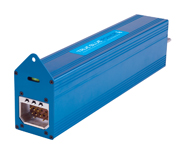 Mid-Continent Instrument Co., Inc. has further strengthened its True Blue Power division by signing a distribution and supply agreement with A123 Systems, Inc. by which Mid-Continent will offer A123’s advanced Nanophosphate lithium-ion battery technology for aviation applications. Mid-Continent Instrument Co., Inc. has further strengthened its True Blue Power division by signing a distribution and supply agreement with A123 Systems, Inc. by which Mid-Continent will offer A123’s advanced Nanophosphate lithium-ion battery technology for aviation applications.
True Blue Power, which was announced in March 2011, initially began by offering two inverters and the TS835 Emergency Power Supply (EPS), the industry’s first FAA TSO-approved EPS to feature A123 technology. Lithium-ion battery technology offers stable chemistry, faster charging, consistent output, excellent cycle life and superior cost performance. Under the agreement with A123, True Blue Power will provide lithium-ion cells, modules and custom power solutions to the aviation community.
“Mid-Continent’s True Blue Power division will work with customers to develop custom power solutions utilizing A123’s innovative lithium-ion chemistry for a wide range of aviation-related applications,” said John Gallman, True Blue Power division director. “A123’s Nanophosphate battery technology clearly offers advantages over lead-acid products, including faster charging and consistent power over a wide state-of-charge (SOC) range. This translates into smaller, lighter products.” For example, the True Blue Power TS835 Emergency Power Supply, which features lithium-ion batteries from A123, is more than 66 percent lighter than its competition.
|
| |

|
 |
Event Listings |
 |
 |
 Battery Power 2012
Early Registration Discounts Available Through July 26! Battery Power 2012
Early Registration Discounts Available Through July 26!
Join hundreds of industry professionals attending Battery Power 2012 and discover the latest market and manufacturing trends impacting battery and power management systems.
For the past 10 years, Battery Power has provided attendees with exceptional technical presentations from industry-leading companies on battery technology, charging and testing systems, standards and regulations, as well as battery manufacturing, materials and research & development. This year’s event will feature more than 35 sessions, designed specifically for battery manufacturers, distributors, OEMs, design engineers and power integrators.
The pre-conference workshops provide in-depth, hands on training on various topics from designing to shipping Li-Ion batteries. There is also a free tour available for the National Renewable Energy Laboratory.
• Discover How New Technology is Impacting Power Management
• See the Latest Products Technologies Unveiled
• Learn to Optimize Your System Performance and Dependability
• Assure Compliance with Latest Safety Requirements and Standards
• Discuss Your Specific System Needs with Technology Experts
• Improve System Longevity and Power Delivery
• Maximize Return on Battery Technology System Investments
• Find the Latest Market, Pricing and Manufacturing
Trends Worldwide
If you are involved in the battery industry or if your products and systems run on batteries, this is a must attend event.
Click here to register.
|
 |
 |
|
 |
 |
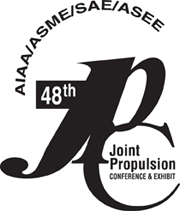 10th International Energy Conversion Engineering Conference 10th International Energy Conversion Engineering Conference
July 29-August 1
Atlanta, Ga.
The 10th International Energy Conversion Engineering Conference (IECEC), co-located with the AIAA Joint Propulsion Conference, provides a forum to present and discuss engineering aspects of energy conversion technology, advanced energy and power systems, devices for terrestrial energy systems and aerospace applications, and the policies, programs, and environmental impacts associated with the development and utilization of these technologies.
INTELEC 2012, Conference and Exhibition
September 30-October 4
Scottsdale, Ariz.
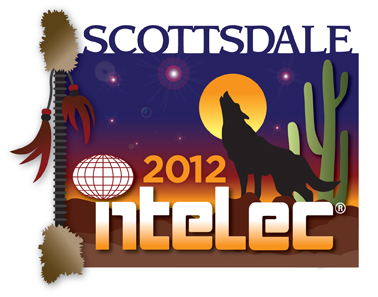 INTELEC 2012 , the International Telecommunications Energy Conference, will be held between September 30 and October 4, 2012 at the Talking Stick Resort and Conference Center in Sunny Scottsdale, Arizona. The conference theme is “Star gazing in the desert: What keeps power people up at night?” INTELEC 2012 , the International Telecommunications Energy Conference, will be held between September 30 and October 4, 2012 at the Talking Stick Resort and Conference Center in Sunny Scottsdale, Arizona. The conference theme is “Star gazing in the desert: What keeps power people up at night?”
For more information on INTELEC please see www.intelec.org.
INTELEC 2012 will feature a technical exhibition. If you manufacture, distribute, sell or service products related to telecommunications or computer energy systems the INTELEC 2012 exhibit is the place for you.
The conference program will include key note speech by General Russel Honore who led Task Force Katrina and plenary sessions, technical presentations, exhibitor seminars, workshops and poster sessions.
 IDGA’s Future Power Summit IDGA’s Future Power Summit
October 10-12
Washington, D.C.
IDGA’s Future Power Summit will focus on R&D and application of cutting-edge, economical power sources into military installations, housing complexes and vehicle. Plus, you’ll learn about acquisition of commercial solutions into military systems (see event brochure).
Network with a range of leaders who decide the future of military power through aggressive energy goals and engineers who work hard to build capabilities to meet these goals. Speakers include:
· Honorable Katherine Hammack - Assistant Secretary of the Army (Installations, Energy & Environment)
· Tom Hicks SES - Deputy Assistant Secretary of the Navy (Energy)
· James Holland - Deputy for Installation Policy, AF Installations (SAF/IEI)
· Captain Lynn Peterson USN - Deputy Director, Electric Ships Office (PMS 320)
· Michael Gallagher - Program Manager, Expeditionary Power Systems, Marine Corps Systems Command
|
 |
| |
Contact Us |
|
| |
Submit editorial content to Shannon Given at 608-351-9245
For advertising information contact Jeremy Fleming at 800-803-9488 X121
Webcom Communications • 7355 E. Orchard Road, Suite 100; Greenwood Village, CO 80111
Phone: 800-803-9488 • Fax: 720-528-3771 • www.infowebcom.com |
|
| |
© 2012 Webcom Communications Corp. |
|
|
|
|
|
|